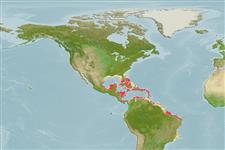>
Eupercaria/misc (Various families in series Eupercaria) >
Scaridae (Parrotfishes) > Scarinae
Etymology: Scarus: Greek, skaros = a fish described by anciente writers as a parrot fish; 1601 (Ref. 45335).
Environment: milieu / climate zone / depth range / distribution range
Ecologia
marinhas associadas(os) a recifes; intervalo de profundidade 3 - 25 m (Ref. 9710). Tropical; 39°N - 24°S, 98°W - 31°W
Western Atlantic: Maryland in the USA, Bermuda and Bahamas to Rio de Janeiro, Brazil (Ref. 13628), including the West Indies (Ref. 3802); absent in the northern Gulf of Mexico.
Length at first maturity / Tamanho / Peso / Idade
Maturity: Lm ?, range 31 - ? cm
Max length : 120 cm TL macho/indeterminado; (Ref. 7251); common length : 35.0 cm TL macho/indeterminado; (Ref. 3802)
Espinhos dorsais (total) : 9; Raios dorsais moles (total) : 10; Espinhos anais: 2; Raios anais moles: 9. Adults uniformly blue, with yellow area on top of head that disappears in larger fish. Large fish develop prominent bulging snout and extended upper and lower caudal fin lobes. No other species has this uniform blue color in adults. (Ref. 26938).
Inhabits coral reefs. Juveniles found on Thalassia beds (Ref. 13628). Feeds on benthic plants and small organisms in the sand (Ref. 5521). Forms large spawning aggregations (Ref. 9710).
Life cycle and mating behavior
Maturidade | Reprodução | Desova | Ovos | Fecundidade | Larvas
Oviparous, distinct pairing during breeding (Ref. 205).
Parenti, P. and J.E. Randall, 2000. An annotated checklist of the species of the labroid fish families Labridae and Scaridae. Ichthyol. Bull. J.L.B. Smith Inst. Ichthyol. (68):1-97. (Ref. 35918)
Categoria na Lista Vermelha da IUCN (Ref. 130435: Version 2024-2)
Ameaça para o homem
Reports of ciguatera poisoning (Ref. 4690)
Utilização humana
Pescarias: pouco comercial; peixe desportivo: sim; Aquário: Espécies comerciais
Ferramentas
Relatórios especiais
Descarregue XML
Fontes da internet
Estimates based on models
Preferred temperature (Ref.
123201): 26.1 - 28.2, mean 27.4 °C (based on 685 cells).
Phylogenetic diversity index (Ref.
82804): PD
50 = 0.5000 [Uniqueness, from 0.5 = low to 2.0 = high].
Bayesian length-weight: a=0.01288 (0.00726 - 0.02285), b=3.04 (2.89 - 3.19), in cm total length, based on LWR estimates for this species & Genus-body shape (Ref.
93245).
Nível Trófico (Ref.
69278): 2.0 ±0.00 se; based on food items.
Generation time: 3.4 ( na - na) years. Estimated as median ln(3)/K based on 1
growth studies.
Resiliência (Ref.
120179): Médio, tempo mínimo de duplicação da população 1,4 - 4,4 anos (Preliminary K or Fecundity.).
Fishing Vulnerability (Ref.
59153): Moderate vulnerability (42 of 100).
Nutrients (Ref.
124155): Calcium = 21.2 [13.4, 36.4] mg/100g; Iron = 0.618 [0.415, 0.940] mg/100g; Protein = 18.9 [16.7, 20.7] %; Omega3 = 0.0733 [, ] g/100g; Selenium = 24.4 [14.4, 40.4] μg/100g; VitaminA = 26.2 [7.6, 89.8] μg/100g; Zinc = 1.64 [1.22, 2.15] mg/100g (wet weight);
